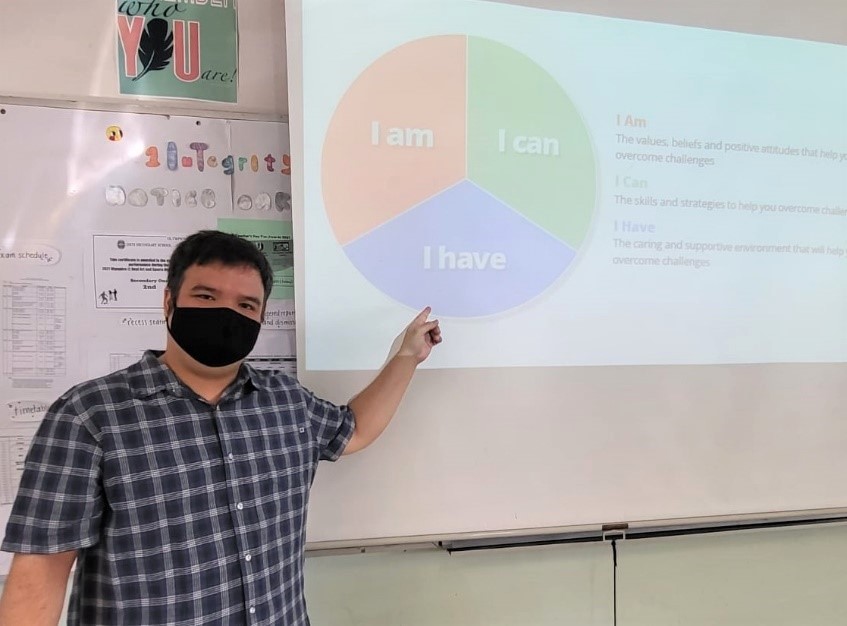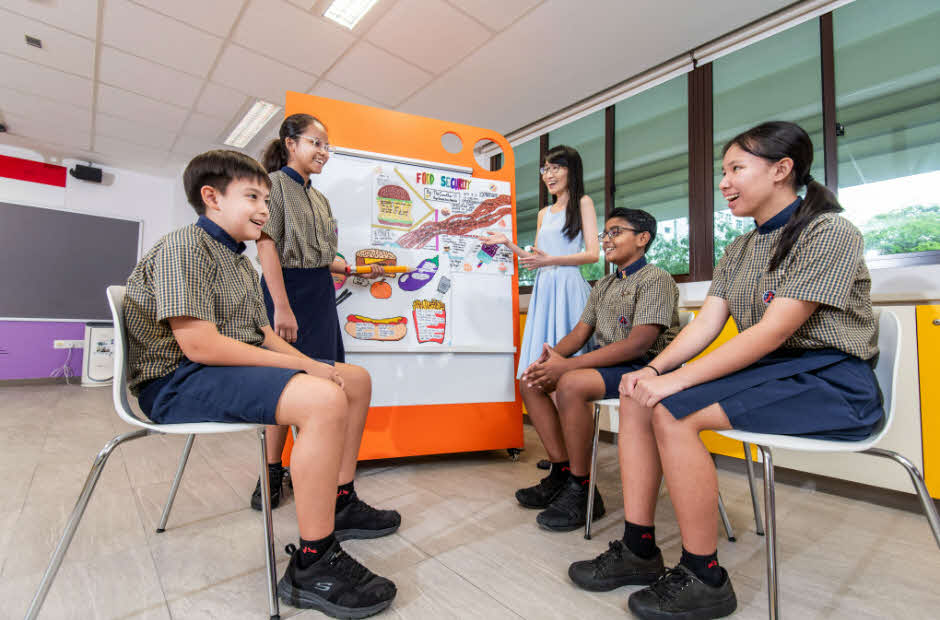James Han Choon Boon, Blangah Rise Primary School, President’s Award for Teachers 2021 Finalist
The idea of cultivating a virtuous student body may seem like a lofty ambition, but thanks to James Han, even seven-year-olds at Blangah Rise Primary School are now embodying traits like responsibility, moderation and self-discipline.
This was the result of the schoolwide implementation of The Virtues Project, a popular international framework of 52 virtues, that has been adapted for the school in 2020. The framework was intended to reshape teacher-student relationships, help students be more engaged in school, and solve student management issues.
At the heart of it, James and his peers are striving to be better mentors to their students.
Beyond all this, it also became clear that the need to impart strong virtues was becoming increasingly urgent. “We’re trying to help students build a strong moral compass in the digital age so that their sense of worth is not defined by superficial likes and dislikes,” said James, who helms the project.
“Every child has innate virtues. It is our role as teachers to awaken them,” he adds.
Making virtues accessible and fun
James and his colleagues developed a holistic framework for engaging even the youngest students. To do that, they used the Five Strategies of the Virtues Project, first of which was to speak the language of virtues. When teachers speak the language of virtues to acknowledge, guide or correct, students learn how their actions are related to the virtues.
As their understanding of the virtues may be vague, it is important to show the children what the virtues look like and what the signs of success are,” he emphasised, citing how a student who admits to forgetting to do his or her homework will have demonstrated responsibility, and it is important to acknowledge that.
Iteration in myriad forms has been key to the programme’s early success. There are multiple ways through which James and his fellow teachers make virtues age-appropriate and digestible, ranging from morning conversations and journaling, to the Virtues Challenge Board where students are encouraged to put up shoutout cards to affirm classmates who have demonstrated a ‘virtue’. In James’ class, his students manage and curate the contents of the board on their own.
Teachers are more than knowledge transmitters
What has morphed the most, however, is the definition of the teacher’s role within the school and the way they address their students — to speak the “language of virtues” in their daily interactions.
Within the virtues framework, a teacher is collectively a coach who imparts skills and knowledge; a cheerleader who celebrates a student’s every success, big or small; and a counsellor, the significant adult whom children can confide in.
Since last 2020, each student has been assigned two or three teacher-mentors who could be his or her form teachers, subject teachers or co-curricular activities (CCA) teachers, and is encouraged to approach them for troubling issues.
“My personal reflection is that when I practise active listening without judging, my students are willing to share more about themselves,” he said.
Another strategy is for teachers to recognise teachable moments, which are often fleeting. James recounted the story of a boy who took the initiative to purchase foolscap paper for a classmate who had run out. He immediately praised the student for his caring behaviour. “This was an instance of catching him doing good and recognising it. Teachable moments do not always have to come from something negative,” he said.
The Virtues Project falls neatly into the goals of the Character and Citizenship Education (CCE) syllabus in 2021, said James, which are to build strong character and help students become active future-ready citizens while ensuring their social and emotional well-being. He uses the analogy of the head, heart and hands to explain the school’s three-pronged approach.
The Seven Habits of Highly Effective People, which the teachers impart, are the simple actions (hand) that students can enact quickly daily. The “head” is the growth mindset that James encourages the team to adopt towards their students—that is to say, every individual has the potential to be more. The Virtues Project then forms the heart of the CCE programme by instilling morals.
Far-reaching impact of imparting virtues
“If you want the child to submit work on time, you awaken diligence by building routines. You want your students to put in effort, you awaken the virtues of excellence and responsibility,” said James, who helped his teaching colleagues see the intricate link between character building and learning engagement.
Among James’ students who demonstrated transformation through the Virtues Project was Jansen (not his real name). He had little confidence in English class because he had never passed a test since Primary 4 and felt unacknowledged by his classmates who always had the right answers.
That was when James started to actively play the role of the cheerleader. In class, James encouraged Jansen to answer the simpler questions to “set off the quick wins”. He also made the subject more fun by getting Jansen to create a game for his younger sister to help her learn some simple idioms. Together with a partner, Jansen selected and wrote the phrases and game instructions onto little cards.
“The outcome was that he passed his English for the first time, in the PSLE last year,” said James, who during the year kept in consistent contact with Jansen’s parents, his other subject teachers and his CCA teacher to work together on his growth.
James also recounted the story of Jansen’s classmate Mary (not her real name), who struggled to write a 200-word composition the first time she entered his class. Mary had a fixed mindset that she was not able to do it then. By coaching the virtue of diligence through deliberate practice and instilling a growth mindset, Mary blossomed and achieved her goal of entering the Express stream.
That was not all.
James shared that since starting the Virtues Project, disciplinary cases have generally come down across the school. With Virtues Circles, teacher-mentors come together to discuss how to best support students in need. The circles begin with the teachers’ reflections, using virtue reflection cards to set the stage for a virtues-focused discussion. “It is no longer just ‘your student’ or ‘my student’ but ‘our student’ and teachers are more open to discussion,” he said.
Another shift James noticed during Virtues Circles held among the teachers, is that the teachers now preface student reviews with their innate strengths, before talking about the virtues that they intend to rouse in the student.
The next step is to enhance the school’s discipline framework. With the perspective that discipline should be restorative, not retributive, James advocates for misbehaving students to take on service learning projects to rebuild their relationship with the school community. “It’s like, we know you’re good at soccer. Why don’t you teach some younger ones? This way, you can do something for the community,” he explained.
Seeing the good in every child and teacher
James’ mindful approach is heavily influenced by what transpired during his junior college days. Coming from a financially disadvantaged family, he took on a part-time job at the 7-11 convenience store, and ended up dozing off during lectures and falling behind in his grades.
“Instead of reprimanding me, my form teacher Mrs Leong sat me down and gave me a vitamin C tablet,” he said. The show of care for his health opened the way for a good conversation. Through her counsel, James eventually left his part-time job; he went on to do well enough to enter NIE to become a teacher, to pay it forward.
“I see the potential in some of these students. They may be held back because of circumstances beyond their control. I really want to encourage them to try their best,” said James.
Beyond what the Virtues Project is doing for the children, James has gone many extra miles in being a positive force for his colleagues. “Instead of just saying ‘good job‘ when teachers demonstrate innovation in their work, we celebrate it by entering them in the MOE Innergy Schools Award,” said James, who has submitted about 20 projects for nomination over the last two years — two of them received commendation awards.
He also manages an “Inspiring Teacher Award” to recognise colleagues who have excelled in teaching, leading CCAs and using blended learning techniques, among other areas. In addition, he launched Staff Bulletin, newsletter to recognise best practices, put together a learning journal for coworkers to aid in their planning and reflection, and devised frameworks for teachers to come together in Professional Learning Teams. For his efforts, James picked up the MOE Distinguished InnoChamp Award and Associate of AST Award in 2020.
While accolades are affirming, nothing is as satisfying as witnessing the growth of his charges. Last year, James ran into former students who are now in polytechnics, who said they never forgot how he had encouraged them not to give up. His encouragement was enough for them to act on his words.
James mused, “That reaffirmed to me that it is through the passage of time that we see changes. It was really a moment to savour.”







.jpg)
